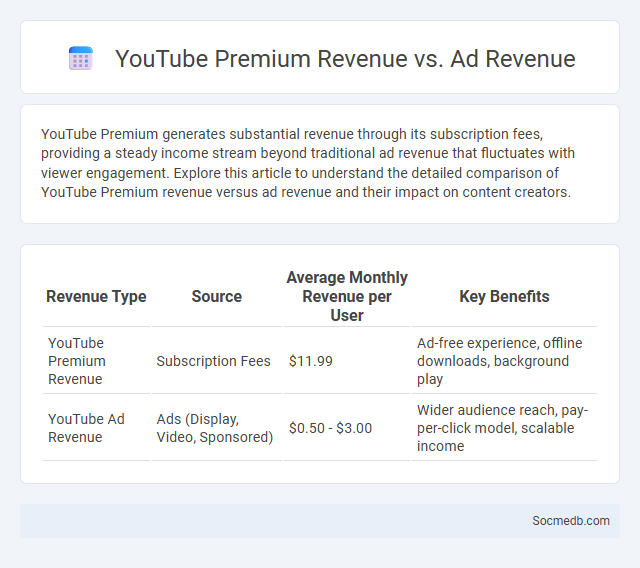
Photo illustration: YouTube Premium Revenue vs Ad Revenue
YouTube Premium generates substantial revenue through its subscription fees, providing a steady income stream beyond traditional ad revenue that fluctuates with viewer engagement. Explore this article to understand the detailed comparison of YouTube Premium revenue versus ad revenue and their impact on content creators.
Table of Comparison
| Revenue Type | Source | Average Monthly Revenue per User | Key Benefits |
|---|---|---|---|
| YouTube Premium Revenue | Subscription Fees | $11.99 | Ad-free experience, offline downloads, background play |
| YouTube Ad Revenue | Ads (Display, Video, Sponsored) | $0.50 - $3.00 | Wider audience reach, pay-per-click model, scalable income |
Understanding YouTube Monetization Models
YouTube monetization models primarily include ad revenue, channel memberships, Super Chat, and merchandise shelf integration, offering diverse income streams for content creators. Ad revenue is driven by cost-per-thousand impressions (CPM) and cost-per-click (CPC) advertising, which vary based on audience demographics and content niche. Leveraging YouTube Partner Program guidelines and analytics tools optimizes monetization potential, enhancing earnings through targeted content and audience engagement.
Overview of YouTube Premium Revenue
YouTube Premium generates revenue primarily through subscription fees, offering an ad-free experience, background playback, and access to exclusive content. As of 2024, YouTube Premium has over 80 million paid subscribers worldwide, contributing significantly to Alphabet Inc.'s overall earnings. The service's steady growth is fueled by increasing demand for uninterrupted video streaming and enhanced user features.
Breaking Down YouTube Ad Revenue
YouTube ad revenue primarily comes from video advertisements played before, during, or after content, generating billions annually for creators and the platform. Advertisers pay based on cost-per-click (CPC) or cost-per-thousand-impressions (CPM), with CPM rates varying by viewer location, niche, and seasonality. YouTube shares approximately 55% of ad revenue with creators, incentivizing high-quality content that drives viewer engagement and longer watch times.
Key Differences: Premium Revenue vs Ad Revenue
Premium revenue from social media platforms stems from subscription-based models, exclusive content, and direct user payments, offering creators a steady and predictable income stream. Ad revenue relies on advertising impressions, clicks, and targeted campaigns, fluctuating based on user engagement and advertiser demand. While premium revenue prioritizes user value and content quality, ad revenue focuses on maximizing audience reach and monetization through third-party advertisers.
Revenue Share: How Creators Get Paid
Social media platforms typically generate revenue through advertising, which is then shared with creators based on engagement metrics like views, clicks, or impressions. Your earnings depend on factors such as follower count, content niche, and viewer interaction, which influence the platform's algorithm in allocating ad revenue. Understanding the platform's revenue share model can help you maximize your income potential from sponsored content and partnerships.
Impact of YouTube Premium on Creator Earnings
YouTube Premium significantly boosts creator earnings by providing a steady revenue stream that isn't reliant on ad impressions, allowing your content to generate income even when viewers use ad blockers. By offering exclusive access and enhanced viewing experiences, it encourages subscribers to support creators directly through their monthly fees. This model diversifies income sources, making creator revenue more predictable and less vulnerable to fluctuations in advertising markets.
Growth Trends: Premium vs Ad Revenue
Social media platforms are experiencing a significant shift in revenue streams, with premium subscription models showing faster growth rates compared to traditional ad revenue. Consumer willingness to pay for ad-free experiences and exclusive content is driving the expansion of premium services on platforms like Twitter Blue and YouTube Premium. Despite this, ad revenue remains a dominant source, supported by increased digital advertising budgets and advanced targeting technologies enhancing ROI for marketers.
Audience Insights: Subscriber Value vs Advertiser Value
Audience insights reveal that your subscribers drive long-term engagement and brand loyalty, providing consistent value beyond immediate interactions. Advertisers prioritize reach and conversions, focusing on metrics like click-through rates and impressions to maximize their return on investment. Balancing subscriber value with advertiser goals enhances both user experience and monetization opportunities on social media platforms.
Regional Variations in Revenue Streams
Social media revenue streams vary significantly by region, with North America predominantly driven by advertising income, while Asia-Pacific markets increasingly capitalize on e-commerce integrations and virtual gifts. European platforms generate substantial revenue through subscription models and premium content services, reflecting diverse consumer preferences and regulatory environments. Emerging markets in Latin America and Africa show rapid growth in influencer marketing and localized mobile payment solutions, aligning with rising smartphone penetration and digital adoption rates.
Maximizing Earnings: Strategies for Creators
Creators maximize earnings on social media by leveraging multiple revenue streams such as brand partnerships, sponsored content, and affiliate marketing. Employing data analytics enables targeted audience engagement, enhancing monetization opportunities through personalized content. Consistent quality production combined with audience interaction fosters loyalty, driving higher conversion rates and sustainable income growth.
 socmedb.com
socmedb.com